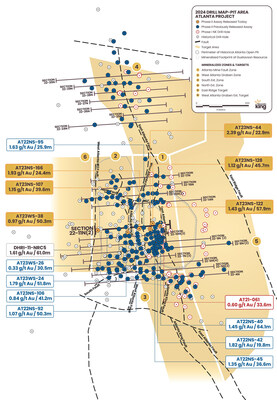VANCOUVER, BC, Jan. 11, 2024 /PRNewswire/ - Nevada King Gold Corp. (TSXV: NKG) (OTCQX: NKGFF) ("Nevada King" or the "Company") is pleased to announce assay results from six reverse circulation ("RC") holes recently completed at its Atlanta Gold Mine Project located 264km northeast of Las Vegas, Nevada, in the prolific Battle Mountain Trend. Today's holes are plotted in plan and section on Figures 1 and 2 below.
Highlights:
Hole No.
| From (m)
| To (m)
| Interval (m)
| Au (g/t)
| Ag (g/t)
| Zone
|
AT23WS-38
| 327.7
| 378.0
| 50.3
| 0.97
| 5.2
| WAGZ
|
AT23NS-107
| 266.8
| 306.4
| 39.6
| 1.15
| 16.4
| WAGZ
|
AT23NS-166
| 158.5
| 182.9
| 24.4
| 1.93
| 51.3
| AMFZ
|
AT23NS-044
| 100.6
| 123.5
| 22.9
| 2.39
| 48.0
| AMFZ
|
AT23NS-128
| 79.3
| 125.0
| 45.7
| 1.12
| 58.8
| AMFZ
|
AT23NS-122
| 19.8
| 77.7
| 57.9
| 1.43
| 24.0
| AMFZ
|
Table 1. Holes released today along Section 11N(2). Mineralization occurs along near-horizontal horizons with true mineralized thickness in vertical holes estimated to be 85% to 95% of reported drill intercept length.
- Four of today's holes crossed the Atlanta Mine Fault Zone ("AMFZ") and were collared to fill-in drill pattern gaps and better define feeder faults. Good lateral continuity in mineralization is present, with gold and silver grades ranging from 1.12 g/t Au to 2.39 g/t Au and 24.0 g/t to 58.8 g/t Ag, while true thicknesses range from 22.9m to 57.9m. Mineralization within individual fault blocks are being better defined with closely-spaced holes, thus adding definition to the grade distribution and highlighting the importance of high-angle faults that generally localize higher grade and thicker mineralization.
- AT23NS-107 (39.6m @ 1.15 g/t Au) was a 17m step out to the south from previously released AT23NS-106 (41.2m @ 0.84 g/t Au) to test for lateral continuity of grade and thickness within the same fault block. These intercepts exhibit close agreement in grade, thickness, and intercept depth, adding confidence to our understanding of the structural controls on the mineralization.
- Sited in the western portion of the West Atlanta Graben Zone ("WAGZ"), hole AT23WS-38 (50.3m @ 0.97 g/t Au) stepped out 40m westward from previously released AT23WS-26 (30.5m @ 0.33 g/t Au) and shows a three-fold increase in grade over a thicker interval, approaching the West Atlanta Fault #2. Historical core hole DHRI-11-NRC5 is located approximately 15m east of AT23WS-38 and intercepted 1.61 g/t Au over 61m, and illustrates the variability in grade within the mineralized porphyritic dacite intrusive unit where grade is more structurally controlled compared to other portions of the resource zone.
Cal Herron, Exploration Manager of Nevada King, stated, "Today's results along Section 23-11N(2) are located in the central portion of the Atlanta resource zone and continue to be very positiive. We know that the highest grades and thicknesses within the WAGZ occur in the southern portion of the resource zone along sections 4N through 9N and to the north along sections 14N through 17N, which is likely due to the presence of E-W trending faults cutting across these portions of the Atlanta system. Such E-W trending faults may also occur in the central portion of the WAGZ, where drilling density is lower and where several holes are pending that will ultimately be plotted on Sections 12N and 13N. As more hole results come in, we'll get a much better handle on the grade distribution and in turn be more able to track higher grade structural corridors through this thick, low grade blanket."


Hole No.
| From (m)
| To (m)
| Interval (m)
| Au (g/t)
| Ag (g/t)
|
AT22NS-40
| 15.2
| 79.3
| 64.1
| 1.45
| 32.7
|
AT22NS-42
| 61.0
| 80.8
| 19.8
| 1.82
| 31.0
|
AT22NS-45
| 70.1
| 106.7
| 36.6
| 1.35
| 34.7
|
AT22NS-92
| 181.4
| 231.7
| 50.3
| 1.07
| 64.0
|
AT22NS-95
| 129.6
| 155.5
| 25.9
| 1.63
| 67.3
|
AT23NS-106
| 268.3
| 309.5
| 41.2
| 0.84
| 14.1
|
AT23WS-24
| 324.7
| 376.5
| 51.8
| 1.79
| 21.1
|
AT23WS-26
| 306.4
| 336.9
| 30.5
| 0.33
| 3.2
|
AT21-61
| 3
| 36.6
| 33.6
| 0.60
| 16.7
|
Table 2. Previously reported holes used along updated Section 22-11N(2). AT22 series holes were drilled by Nevada King in 2022 and the AT21 series holes were drilled in 2021. True thickness of gold mineralization interpreted in today's release is 90% to 100% of the reported intercept length in vertical holes.
Hole No.
| From (m)
| To (m)
| Interval (m)
| Au (g/t)
| Ag (g/t)
|
DHRI-11-NRC5
| 312.5
| 373.5
| 61.0
| 1.61
| 9.09
|
Table 3. Historical hole used in updated Section 22-11N(2). DHRI series hole was drilled by Meadow Bay in 2011. True thickness of gold mineralization interpreted in today's release is 90% to 100% of the reported intercept length in vertical holes.
QAQC Protocols
All RC samples from the Atlanta Project are split at the drill site and placed in cloth and plastic bags utilizing a nominal 2kg sample weight. CRF standards, blanks, and duplicates are inserted into the sample stream on-site on a one-in-twenty sample basis, meaning all three inserts are included in each 20-sample group. Samples are shipped by a local contractor in large sample shipping crates directly to American Assay Lab in Reno, Nevada, with full custody being maintained at all times. At American Assay Lab, samples were weighed then crushed to 75% passing 2mm and pulverized to 85% passing 75 microns in order to produce a 300g pulverized split. Prepared samples are initially run using a four acid + boric acid digestion process and conventional multi-element ICP-OES analysis. Gold assays are initially run using 30-gram samples by lead fire assay with an OES finish to a 0.003 ppm detection limit, with samples greater than 10 ppm finished gravimetrically. Silver samples that run greater than 100ppm are also finished gravimetrically. Every sample is also run through a cyanide leach for gold with an ICP-OES finish. The QA/QC procedure involves regular submission of Certified Analytical Standards and property-specific duplicates.
Qualified Person
The scientific and technical information in this news release has been reviewed and approved by Calvin R. Herron, P.Geo., who is a Qualified Person as defined by National Instrument 43-101 ("NI 43-101").
About Nevada King Gold Corp.
Nevada King is the third largest mineral claim holder in the State of Nevada, behind Nevada Gold Mines (Barrick/Newmont) and Kinross Gold. Starting in 2016, the Company has staked large project areas hosting significant historical exploration work along the Battle Mountain trend located close to current or former producing gold mines. These project areas were initially targeted based on their potential for hosting multi-million-ounce gold deposits and were subsequently staked following a detailed geological evaluation. District-scale projects in Nevada King's portfolio include (1) the 100% owned Atlanta Mine, located 100km southeast of Ely, (2) the Lewis and Horse Mountain-Mill Creek projects, both located between Nevada Gold Mines' large Phoenix and Pipeline mines, and (3) the Iron Point project, located 35km east of Winnemucca, Nevada.
The Atlanta Mine is a historical gold-silver producer with a NI 43-101 compliant pit-constrained resource of 460,000 oz Au in the measured and indicated category (11.0M tonnes at 1.3 g/t) plus an inferred resource of 142,000 oz Au (5.3M tonnes at 0.83 g/t). See the NI 43-101 Technical Report on Resources titled "Atlanta Property, Lincoln County, NV" with an effective date of October 6, 2020, and a report date of December 22, 2020, as prepared by Gustavson Associates and filed under the Company's profile on SEDAR+ (www.sedarplus.ca).
Resource Category
| Tonnes
(000s)
| Au
Grade
(ppm)
| Contained Au
Oz
| Ag Grade
(ppm)
| Contained Ag
Oz
|
Measured
| 4,130
| 1.51
| 200,000
| 14.0
| 1,860,000
|
Indicated
| 6,910
| 1.17
| 260,000
| 10.6
| 2,360,000
|
Measured + Indicated
| 11,000
| 1.30
| 460,000
| 11.9
| 4,220,000
|
Inferred
| 5,310
| 0.83
| 142,000
| 7.3
| 1,240,000
|
Table 4. NI 43-101 Mineral Resources at the Atlanta Mine
Please see the Company's website at www.nevadaking.ca.
Neither the TSX Venture Exchange nor its Regulation Services Provider (as that term is defined in the policies of the TSX Venture Exchange) accepts responsibility for the adequacy or accuracy of this release.
Cautionary Statements Regarding Forward Looking Information
This news release contains certain "forward-looking information" and "forward-looking statements" (collectively "forward-looking statements") within the meaning of applicable securities legislation. All statements, other than statements of historical fact, included herein, without limitation, statements relating the future operations and activities of Nevada King, are forward-looking statements. Forward-looking statements are frequently, but not always, identified by words such as "expects", "anticipates", "believes", "intends", "estimates", "potential", "possible", and similar expressions, or statements that events, conditions, or results "will", "may", "could", or "should" occur or be achieved. Forward-looking statements in this news release relate to, among other things, the Company's exploration plans and the Company's ability to potentially expand mineral resources and the impact thereon. There can be no assurance that such statements will prove to be accurate, and actual results and future events could differ materially from those anticipated in such statements. Forward-looking statements reflect the beliefs, opinions and projections on the date the statements are made and are based upon a number of assumptions and estimates that, while considered reasonable by Nevada King, are inherently subject to significant business, economic, competitive, political and social uncertainties and contingencies. Many factors, both known and unknown, could cause actual results, performance or achievements to be materially different from the results, performance or achievements that are or may be expressed or implied by such forward-looking statements and the parties have made assumptions and estimates based on or related to many of these factors. Such factors include, without limitation, the ability to complete proposed exploration work, the results of exploration, continued availability of capital, and changes in general economic, market and business conditions. Readers should not place undue reliance on the forward-looking statements and information contained in this news release concerning these items. Nevada King does not assume any obligation to update the forward-looking statements of beliefs, opinions, projections, or other factors, should they change, except as required by applicable securities laws.

 View original content to download multimedia:https://www.prnewswire.com/news-releases/nevada-king-intercepts-1-43-gt-au-over-57-9m-1-12-gt-au-over-45-7m--1-15-gt-au-over-39-6m-at-atlanta-302032207.html
View original content to download multimedia:https://www.prnewswire.com/news-releases/nevada-king-intercepts-1-43-gt-au-over-57-9m-1-12-gt-au-over-45-7m--1-15-gt-au-over-39-6m-at-atlanta-302032207.html
SOURCE Nevada King Gold Corp.
![]() View original content to download multimedia:https://www.prnewswire.com/news-releases/nevada-king-intercepts-1-43-gt-au-over-57-9m-1-12-gt-au-over-45-7m--1-15-gt-au-over-39-6m-at-atlanta-302032207.html
View original content to download multimedia:https://www.prnewswire.com/news-releases/nevada-king-intercepts-1-43-gt-au-over-57-9m-1-12-gt-au-over-45-7m--1-15-gt-au-over-39-6m-at-atlanta-302032207.html









